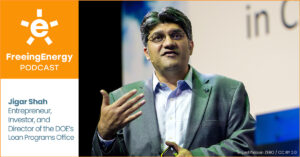On February 7, 2022, the Wall Street Journal’s Editorial board published an opinion piece titled, “California’s Solar-Power Welfare State.” This article weighs in on the debate over net metering—the price that electric utilities pay rooftop solar owners for the excess electricity they send back to the grid. This may sound like a minor, wonky topic, but the outcomes will impact how America generates and consumes energy for decades to come. Disappointingly, the WSJ has parroted the electric utilities’ talk-track and overlooked the deeper opportunity to bring innovation, social equity, and lower bills to families and communities in California and across the country.
To understand what is really going on here, we need to peel back the onion a bit.
People love rooftop solar; utilities don’t

Survey after survey tells us that people love rooftop solar because it helps the environment, lowers their electricity bills, and, when coupled with batteries, protects their families from grid outages. It is popular across income levels, geographies, and political affiliations. Rooftop solar also creates 10-times more jobs for each kilowatt installed and can be built in weeks rather than years like large solar farms.
Electric utilities see this very differently. Every time a customer installs solar, the utilities’ revenue declines. An infamous 2013 paper written by the utility industry illustrates the magnitude of the threat they feel from rooftop solar (or distributed generation as they call it here):
“The electric utility sector has not previously experienced a viable disruptive threat to its service offering… However, a combination of technological innovation, public/regulatory policy, and changes in consumer … preferences has resulted in distributed generation … being on a path to becoming a viable alternative to the electric utility model.”
As this paper states, the utility industry sees local energy systems like rooftop solar as an existential threat. Since rooftop solar is too popular to ban outright, electric utilities have found a more subtle way to slow it down. They are convincing regulators in California and across the US to lower the price paid by utilities for each kilowatt hour rooftop solar owners send into the grid.
The recent fervor over net metering was sparked by California’s proposed (and since tabled) revision to their policies. This proposal slashed prices paid for excess solar and added the highest fixed fee for solar owners ever proposed in the US. Consumer surveys indicated it would have brought California’s vibrant rooftop solar market to a screeching halt. To understand how something so egregious and so unpopular with California voters managed to make it as far as a formal proposal by the state’s regulators, you need to look at the cleverly misleading arguments made by the utilities.
Cost shifting is the bogeyman invented to justify egregious net metering policies
As the WSJ article explains: “Solar customers use the grid to consume and export power. Yet they avoid much of the grid costs, which are shifted to other customers.” In other words, solar customers purchase fewer kilowatt hours, which means they contribute less towards the fixed costs of maintaining the grid, so those fixed costs are shifted to everyone else, particularly impacting low-income families least able to afford them. Superficially, this is a compelling argument so it’s not surprising that regulators and many well-meaning analysts have echoed it. The truth is that utility costs are so complex, and their data is so opaque that there are literally dozens of studies by think tanks, universities, and the US government that come down on every side of the cost-shifting debate. There is little consensus, even among people whose careers focus on the singular issue of electricity prices.
If you read the WSJ article and the many reports by utilities and their supporters, you could be forgiven for thinking the cost-shifting is a brand-new, never-before-seen issue that is so damaging that it warrants decimating rooftop solar to fix it. In truth, cost-shifting is a fundamental part of any industry that shares its assets across customers. Your mobile phone bill, airline ticket, and grocery bill all sit on top of cost-shifts and cross-subsidies between different customer groups. Since its earliest days a century ago, the electric utility industry business model has been built on cost-shifting and cross-subsidies. Suburban families are shifting the costs of their sprawling grids onto families living in densely populated inner cities. Residential customers pay far higher rates per kilowatt hour than industrial customers, effectively subsidizing them. Low-income customers receive significant cost breaks on their electricity bills, which are subsidized by more affluent customers. Rooftop solar isn’t even the biggest cost-shift from affluent to low-income families. In 2019, US utilities saw a $2.7 billion revenue decline due to rooftop solar. That same year, utility revenue declined $5 billion from widespread adoption of LED bulbs. Since LEDs are more expensive up front, studies show they are purchased disproportionately by affluent families, again, cost-shifting or cross-subsidizing the grid’s fixed-costs onto lower-income families.
The electricity industry, like every other asset intensive industry, has been managing cost-shifts and cross-customer subsidies as a day-to-day part of their businesses for decades. So why are cost-shifts from rooftop solar suddenly so divisive? Could it be this fight is less about costs shifting from affluent to low-income families and more that rooftop solar is the first time that control of the electricity industry is shifting from utilities to their customers?
This isn’t about welfare for the wealthy, this is about propping up a broken business model
If utilities were genuinely concerned about cost-shifting to low-income families, they could have advocated for a host of tried-and-true solutions like affordable financing, community solar, landlord incentives, streamlined permitting, and additional rate subsidies, just to name a few.
Instead, the proposed California net metering policy offered to “fix” cost-shifting by making rooftop solar so expensive that no one in the state, affluent or low-income, could afford it. This is a classic example of the cure being worse than the disease.
Disappointingly, the WSJ echoed the utilities’ red herrings about cost-shifting, demonizing net metering altogether, rather than acknowledging that it is one of many cost-shifts that utilities need to intelligently navigate. The WSJ’s article effectively advocates for the benefit of regulated monopolies—a business model that seems to be the very opposite of the lightly regulated, free-market capitalism that WSJ has championed since its inception in 1889. Even WSJ’s own Editorial Board states their mission as “Speaking for free markets…” and against the “ukases of kings and other collectivists…”
Some of the greatest industries on earth like movies, television, microchips, desktop computers, and internet were born in garages and small businesses across California. It’s hard to understand why the state’s leaders and the WSJ think the future of clean energy could possibly emerge from the bureaucratic ivory towers of the state’s struggling electric monopolies.
Rather than advocating for policies that strengthen the status quo of a broken, uncompetitive industry, the WSJ and industry regulators should embrace and encourage competition and innovation in the energy sector, especially small-scale local energy systems like rooftop solar and microgrids as a central part of more resilient, more innovative, lower cost, cleaner, and more equitable energy future.
Bill Nussey
CEO & Founder of Freeing Energy
The core ideas and data points in this article are all borrowed from Bill’s recent book, Freeing Energy: How Innovators Are Using Local-scale Solar and Batteries To Disrupt the Global Energy Industry From the Outside In.



